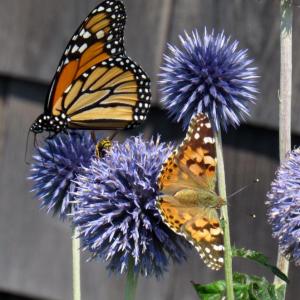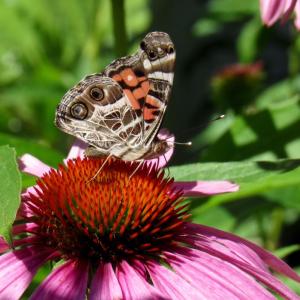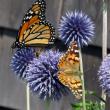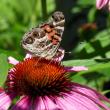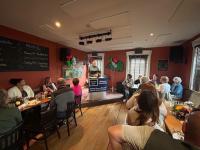Kristen Lindquist: Introducing the Ladies
 Comparison of Monarch (left) and Painted Lady (right) as they feed on globe thistle. (Photo by Kristen Lindquist)
Comparison of Monarch (left) and Painted Lady (right) as they feed on globe thistle. (Photo by Kristen Lindquist)
 "American Ladies have big eyes." You can also see the diagnostic spot on the forewing of this American Lady. (Photo by Kristen Lindquist)
"American Ladies have big eyes." You can also see the diagnostic spot on the forewing of this American Lady. (Photo by Kristen Lindquist)
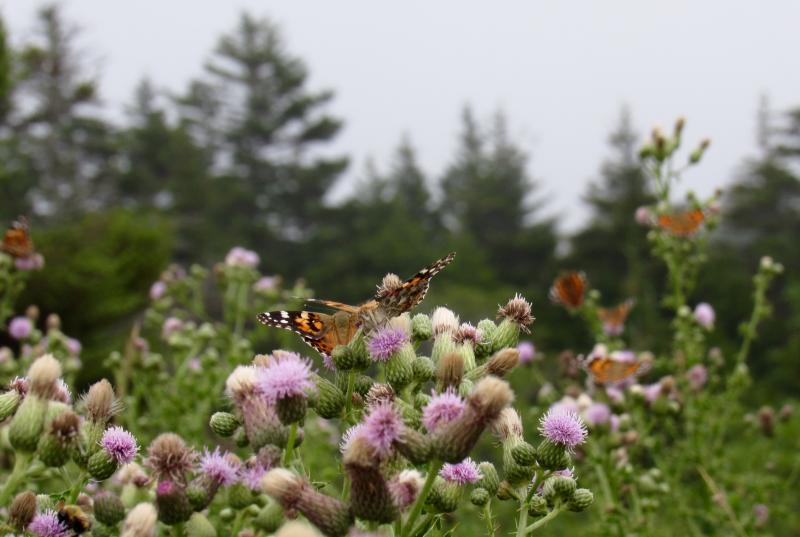 A mere fraction of the dozens of butterflies feeding in this thistle patch on Monhegan. (Photo by Kristen Lindquist)
A mere fraction of the dozens of butterflies feeding in this thistle patch on Monhegan. (Photo by Kristen Lindquist)
 By contrast the Painted Lady has four eyes and no little white spot on the forewing. (Photo by Kristen Lindquist)
By contrast the Painted Lady has four eyes and no little white spot on the forewing. (Photo by Kristen Lindquist)
 American Lady on purple coneflower (Photo by Kristen Lindquist)
American Lady on purple coneflower (Photo by Kristen Lindquist)
 A good view of the upperside of a Painted Lady. (Photo by Kristen Lindquist)
A good view of the upperside of a Painted Lady. (Photo by Kristen Lindquist)
 Comparison of Monarch (left) and Painted Lady (right) as they feed on globe thistle. (Photo by Kristen Lindquist)
Comparison of Monarch (left) and Painted Lady (right) as they feed on globe thistle. (Photo by Kristen Lindquist)
 "American Ladies have big eyes." You can also see the diagnostic spot on the forewing of this American Lady. (Photo by Kristen Lindquist)
"American Ladies have big eyes." You can also see the diagnostic spot on the forewing of this American Lady. (Photo by Kristen Lindquist)
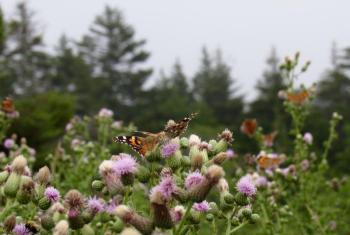 A mere fraction of the dozens of butterflies feeding in this thistle patch on Monhegan. (Photo by Kristen Lindquist)
A mere fraction of the dozens of butterflies feeding in this thistle patch on Monhegan. (Photo by Kristen Lindquist)
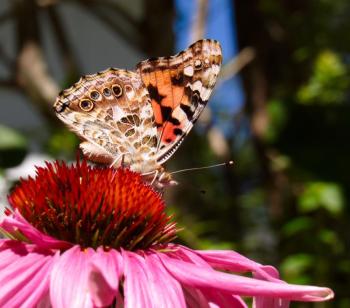 By contrast the Painted Lady has four eyes and no little white spot on the forewing. (Photo by Kristen Lindquist)
By contrast the Painted Lady has four eyes and no little white spot on the forewing. (Photo by Kristen Lindquist)
 American Lady on purple coneflower (Photo by Kristen Lindquist)
American Lady on purple coneflower (Photo by Kristen Lindquist)
 A good view of the upperside of a Painted Lady. (Photo by Kristen Lindquist)
A good view of the upperside of a Painted Lady. (Photo by Kristen Lindquist)
In my flower garden, the small patch of purple coneflower was literally humming: many bees and energetic clouds of butterflies rapidly moved from flower to flower. I watched, transfixed, for a long time as the intricately patterned orange-and-black butterflies fluttered all around me. The term "butterfly kisses" came to mind as I was touched by the delicate beauty of the moment. I made a mental note to plant more coneflower.
Of the two dozen or more butterflies flitting around me, a handful were American Ladies, but most were Painted Ladies. These lovely Ladies are both named Vanessa, that being their genus: American Lady is Vanessa virginiensis; Painted Lady, Vanessa cardui. You could also call them Cynthia after their sub-genus, which distinguishes the four Lady species in the world from 20 or so other Vanessa butterflies. In French-speaking Canada the Painted Lady is known as la Belle Dame, the Beautiful Lady, which seems grandly appropriate for such an attractive and cosmopolitan insect.
These Ladies are indeed finely attired. (And look alike, regardless of gender.) As with many species, the underwing of a Lady sports a distinctly different pattern than the upperwing. Broadly speaking, a butterfly's underwing is usually more muted and much less complexly patterned than the upperwing. The Lady's underwing, however, is arguably even more beautiful than its colorful upperwing. Topside, the insect is orange or reddish-orange with black markings overall and white spots on the forewing tips. Pretty enough. But underneath, the intricate, brown-and-white cob-webbing punctuated by eye spots on the hindwing and subtly washed with pink or orange on the forewing, is spectacular. It's one of those things that blurs the distinction between nature and art, making you question the purpose of such beauty in the world. Few other close butterfly observations are more likely to turn one's thoughts into the existential realm.
Sometimes mistaken for the larger Monarch, the Painted Lady is probably the most common and widespread butterfly you've never heard of, being found almost everywhere in North America and on all other continents except Antarctica and Australia. They overwinter in the southern United States and Mexico and disperse northward by the millions each spring and summer. The American Lady also overwinters in warmer southern climes, although it migrates northward in less dramatic numbers than the Painted Lady.
Individuals we see among our coneflowers in Maine have not miraculously powered all the way here from Mexico. Rather, as overwintering butterflies migrate north, they mate and produce larvae. These caterpillars then metamorphose into more butterflies, which then flutter their little selves even further north. In this way, with up to three broods spanning a summer, the Ladies hopscotch their way to northern New England and across Canada. And then they turn around and start moving south again.
In coastal Maine we see Ladies through mid-summer into October, when freezing temperatures do in any lingering individuals. This year August seems to be prime time. I don't think I've ever seen congregations of this many Painted Ladies in one place before, in flower patches throughout the Midcoast. A friend in northern Vermont reports high numbers there, as well; his theory is that we're seeing southbound individuals now. Conditions must have been optimal for their survival this summer, so unusual among wild creatures these days as to be especially notable and uplifting when it happens.
I first learned to recognize the Ladies—and, just as important, to distinguish them from each other—on Monhegan Island. Bill Loughran, one of my field birding mentors during many years of fall bird migration on the island, would point out some of the other flying things around us when the birding slowed. From him I learned how to tell apart male and female Monarchs. I learned about "AJ"—the Green Darner (Anax junius), a common dragonfly. And I learned from him the phrase, "American Ladies have big eyes," the key to identifying American versus Painted Lady. (After all, ladies don't appreciate it when you call them by the wrong name.)
Both Ladies feature a row of four black spots, or eyes, on the back margins of their hindwings. The underside of the Painted Lady's hindwing reveals all four eye spots, each about the same size and blue at the center. By contrast, the underside of the American Lady's wing shows only two, larger blue eye spots. So when a Lady is perched on a flower, wings folded, you can easily identify if it's the American by its two big eyes. Also, you can often pick out a tiny white dot within an orange area on the outside edge of the upper forewing of the American Lady, but that's much less easy to spot.
On a recent visit to Monhegan this August, I was remembering Bill, who passed away a few years ago, and how much he taught me over the years about the flying fauna of the island. He would have been amazed at the number of "bugs" out there this summer: hundreds of Painted Ladies and a few dozen Monarchs (another uplifting sight, after several summers of next-to-none) busily gathered on patches of thistle, coneflower, phlox, and other flowers around the island. Other visitors to the island also commented on their numbers, similarly heartened, it seemed, by their unexpected and glorious abundance.
 Kristen Lindquist is an amateur naturalist and published poet who lives in her hometown of Camden.
Kristen Lindquist is an amateur naturalist and published poet who lives in her hometown of Camden.
Orchids —They're not just in the tropics
• Meditations on an unlikely harbinger of spring
• Meditations on the Snow Goose
• Sky-watching during the holiday season
• Understanding the Aurora Borealis
• Get to know the constellation Gemini
• Celebrate September’s full moon
• Northern Sky basics with the Big Dipper
• Early Christmas morning: Look up! A full moon, and Orion bright in the sky
Event Date
Address
United States

